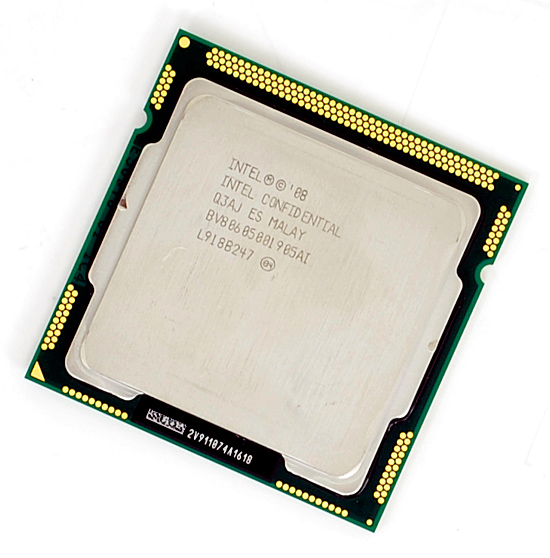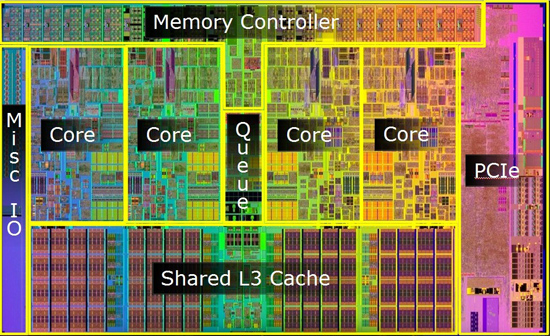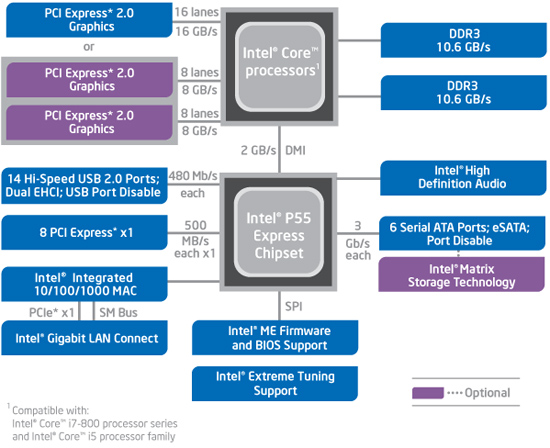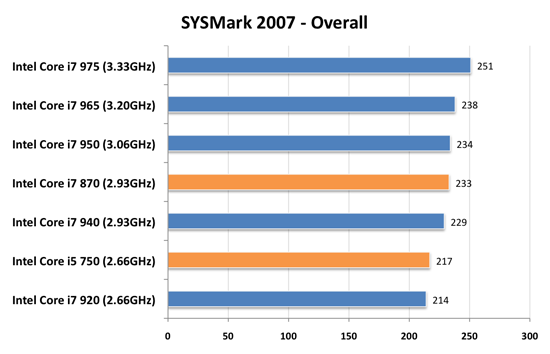Intel's Core i7 870 & i5 750, Lynnfield: Harder, Better, Faster Stronger
by Anand Lal Shimpi on September 8, 2009 12:00 AM EST- Posted in
- CPUs
Intel is on the verge of transitioning to 32nm. We'll see the first parts this year. What do you do with your 45nm fabs when you start moving volume away from them? Make really cheap quad-core Nehalems of course:

I'm talking $196. I'm talking faster than AMD's entire lineup. I'm talking about arguably the best processor of 2009. I'm talking about Lynnfield, and here's its backside:

Mmm
I spent much of the past year harping on AMD selling Nehalem-sized Phenom IIs for less than Intel sold Nehalems. With Lynnfield, Intel actually made Nehalem even bigger all while driving prices down. Like I said, what do you do when you're still making boatloads of money in a recession and are about to start emptying your 45nm fabs?
I should clear things up before we progress much further. Lynnfield is the codename for mainstream 45nm quad-core Nehalem, while Bloomfield refers to the first Nehalem launched at the end of 2008:
| Processor | Manufacturing Process | Die Size | Transistor Count | Socket |
| Bloomfield | 45nm | 263 mm2 | 731M | LGA-1366 |
| Lynnfield | 45nm | 296 mm2 | 774M | LGA-1156 |
Despite being cheaper, Lynnfield is larger than Bloomfield. The larger die is due to one major addition: an on-die PCIe controller.

Bloomfield, The First Nehalem, circa 2008

Lynnfield, Nehalem for All, circa 2009
The pink block to the right of the die is the PCIe controller, that's 16 PCIe 2.0 lanes coming right off the chip. Say hello to ultra low latency GPU communication. You'd think that Intel was about to enter the graphics market or something with a design like this.
Sacrifices were made to reduce CPU, socket and board complexity. Gone are the two QPI links that each provided 25.6GB/s of bandwidth to other CPUs or chips on the motherboard. We also lose one of the three 64-bit DDR3 memory channels, Lynnfield only has two like a normal processor (silly overachieving Bloomfield).

Intel's Bloomfield Platform (X58 + LGA-1366)
The sum is that Lynnfield is exclusively single-socket; there will be no LGA-1156 Skulltrail. While the dual-channel memory controller isn't really a limitation for quad-core parts, six and eight core designs may be better suited for LGA-1366.

Intel's Lynnfield Platform (P55 + LGA-1156)
The loss of QPI means that Lynnfield doesn't have a super fast connection to the rest of the system, but with an on-die PCIe controller it doesn't matter: the GPU is fed right off the CPU.
The Lineup
We get three Lynnfield CPUs today: the Core i7 870, Core i7 860 and the Core i5 750. Intel's branding folks told us that the naming would make sense one we saw the rest of the "Core" parts introduced; yeah that was pretty much a lie. At least there aren't any overlapping part numbers (e.g. Core i5 860 and Core i7 860).
The i7 in this case denotes four cores + Hyper Threading, the i5 means four cores but no Hyper Threading. The rules get more complicated as you bring notebooks into the fray but let's momentarily bask in marginal simplicity.
| Processor | Clock Speed | Cores / Threads | Maximum Single Core Turbo Frequency | TDP | Price |
| Intel Core i7-975 Extreme | 3.33GHz | 4 / 8 | 3.60GHz | 130W | $999 |
| Intel Core i7 965 Extreme | 3.20GHz | 4 / 8 | 3.46GHz | 130W | $999 |
| Intel Core i7 940 | 2.93GHz | 4 / 8 | 3.20GHz | 130W | $562 |
| Intel Core i7 920 | 2.66GHz | 4 / 8 | 2.93GHz | 130W | $284 |
| Intel Core i7 870 | 2.93GHz | 4 / 8 | 3.60GHz | 95W | $562 |
| Intel Core i7 860 | 2.80GHz | 4 / 8 | 3.46GHz | 95W | $284 |
| Intel Core i5 750 | 2.66GHz | 4 / 4 | 3.20GHz | 95W | $196 |
Keeping Hyper Threading off of the Core i5 is purely done to limit performance. There aren't any yield reasons why HT couldn't be enabled.
Intel was very careful with both pricing and performance of its Lynnfield processors. I'm going to go ahead and say it right now, there's no need for any LGA-1366 processors slower than a Core i7 965:

This is only one benchmark, but it's representative of what you're about to see. The Core i7 870 (LGA-1156) is as fast, if not faster, than every single LGA-1366 processor except for the ones that cost $999. Its pricing is competitive as well:

For $196 you're getting a processor that's faster than the Core i7 920. I'm not taking into account motherboard prices either, which are anywhere from $50 - $100 cheaper for LGA-1156 boards. I don't believe LGA-1366 is dead, but there's absolutely no reason to buy anything slower than a 965 if you're going that route.










343 Comments
View All Comments
goinginstyle - Thursday, September 10, 2009 - link
What is worthless here is your continued ramblings about subjects you have no actual knowledge of right now. Do you own a P55 system? If so, let's see an article from you. Really, you come over spouting off and calling everyone idiots, yet, you we do not see any articles from you at Toms about the subject matter. In fact, we do not see any comments from you anywhere else about P55. Toms, Tech Report, and AT all came to the same conclusion, presented the same type of information (although AT discussed subjects like PCIE), and yet you do not comment on those other websites.Either you are posting here because you think your negative posts will somehow get you attention that your mother never gave you or you are doing to try and look important to the people in charge at Toms. I hope to God that they never allow you to post another piece of garbage on their site. Really, that article was a straight copy and paste from several other articles on the subject along with Wikipedia information. I am surprised you were not sued for plagiarism, maybe you were and that is why you are over here.
So far, all of your ramblings have only proved your total lack of intelligence when it comes to computer components. Once again, when will we see you making comments on Toms about their similar coverage or when can you expect to see your expert PP article on the site?
eternalfantasy - Tuesday, September 8, 2009 - link
Fully agree up to the AMD part. This is the most biased review I've seen published by Anandtech to date. I think a "Buy me now!" link at the end of the article with an Intel sponsored Ad will complete the article perfectly.Stock clock speed CPU review is what highstreet mags for average Joes write about. Excluding what's importent for readers of tech sites, such as:
Clock for clock comparison
Maximum overclock with similer priced CPU/platform
is just blatent attempt at glorifying Intel's mainstream platform to look like more then what it really is. A cheaper mainstream alternative to the X58 that has been avaliable over a year ago.
PassingBy - Tuesday, September 8, 2009 - link
As released, Core i5 and 1156 Core i7 have no IGP market, so presumably people reading this review will have no interest in using an IGP.In any case, we can safely say that your prognostications like 'a brain dead platform for brain dead people' were total bullshit, as many people tried to tell you. Now, many more people can place a Nehalem-based system on their list of possible purchases. Clarkdale will extend Nehalem/Westmere to even lower price points (and yes, then you can start comparing IGPs, if you like).
TA152H - Tuesday, September 8, 2009 - link
You're really confused.Honestly, anyone who knows anything about computers would be pretty stupid to get this platform. It's fine stock, but when you throw in overclock, the i7 920 is the better choice.
But, here's your hypocrisy. This article was main for mainstream people, since there's no overclocking comparisons, really. The IGP is what makes AMD work, and they do sell their processors into this market. Anand was commenting on how AMD had to lower their prices, so within this context the entire market is applicable. You didn't understand the context, did you?
I didn't say the platform was brain-dead, although you seem to be. I said it was brain-damaged. It's a Celeron. If you look at the reviews from better sites, you can see the Bloomfield running at the same speed is faster than the brain-damaged Lynnfield. Anand really tried to obfuscate this, by using bad comparisons or those meant to show the Lynnfield in the best light, instead of just presenting the most useful information. He fooled you, because you're a moron, but not everyone.
I do like this site, or I did, but I'm really getting unnerved by the way they test to show what they want to show, instead of test and then make up their minds. It's really problematic, and it's going to bite them when more people figure this out.
imperialsoren - Tuesday, September 8, 2009 - link
You have a nasty way of conversing.IdolObserver - Wednesday, September 9, 2009 - link
It's not only his nasty way of conversing. He also doesn't have a clue what he is talking about.Zymon - Tuesday, September 8, 2009 - link
I agree in the main part - there are many aspects which seem to have been completely ignored in this, and many other reviews of Lynnfield.It seems strange that you haven't used a level playing field between compared systems: ALL 3 platforms can use DDR3 - you've used X48 for Core 2 chips, but apparently used different RAM than i5. Why on earth have you used an AM2+ board and DDR2 ram for AMD? I guess it's *only* been 9 months since AM3 became available?
As mentioned, a true clock-for-clock comparison would be VERY interesting, using the same RAM, at the same speeds and timings between platforms.
Anand Lal Shimpi - Tuesday, September 8, 2009 - link
Sorry if this wasn't made clear in the review but the Phenom II X4 965 BE used the same test platform as our review of that CPU: an AM3 motherboard with DDR3 memory.I'm out of the office now but I'll update the test tables later this evening to reflect this.
Take care,
Anand
Zymon - Tuesday, September 8, 2009 - link
Cheers for the clarification Anand!- It seemed unusual for one of your articles, hence the comment!
Laters..
snakeoil - Tuesday, September 8, 2009 - link
i want to know if those benchmarks were with the turbo enabled, which would be cheating, because that's overclocking.for every benchmark turbo must be disabled to be fair.
readers are not stupid.